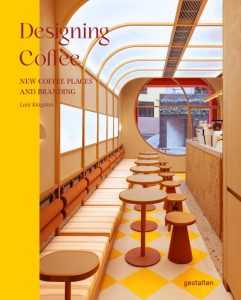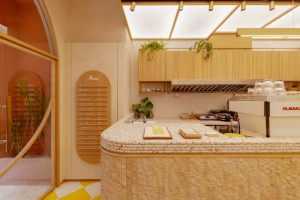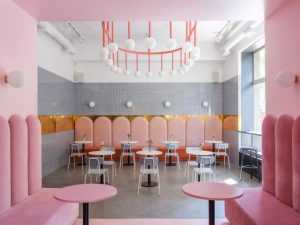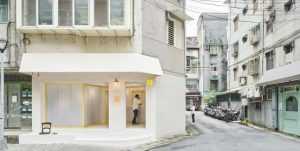MILAN – Lani Kingston is a food writer and consultant. She holds Masters degrees in Food Studies and Education, along with barista and pastry chef qualifications. Her first book, How To Make Coffee, is available in several languages. Designing Coffee- New Coffee Places and Branding published by gestalten in 2023 is her second book with gestalten after the bestseller Spill the Beans.
Kingston, some studies say that having meeting places in one’s neighborhood, such as coffee shops, can help create social moments: so in your opinion, proximity outweigh the design of a coffee shop??
“Cafes and coffeeshops have long been perfect examples of ‘third places’ – important community gathering places outside of the home and workplace. They are integral to community building – offering a low barrier to entry, and are places where people from all ages and demographics can gather and meet in a low stakes setting.

I don’t think that proximity outweighs design in this regard – certain bad design choices can have even the most conveniently placed coffee shops struggling to retain custom. If a space is uncomfortable, unsightly, or doesn’t offer a good experience, people will happily travel further to find these things.
Of course, there are the outliers, and if the next closest coffee shop doesn’t serve very good beverages, offer a better experience, or is too far, people will likely still find a way to turn their local coffee shop into a social gathering place – even if just to collect a takeaway and then take a walk in the park!”.
So a great specialty, served in an anonymous coffee shop, would lose some of its value to the end consumer?
Kingston:”Not necessarily – this is very much dependent upon the consumer. I’ve cupped some phenomenal coffees in classrooms, sterile labs, and what could only really be described as large utility closets!

My experience of the coffee itself was not less valuable. But my intention in consuming these coffees was to experience the coffee itself. But so many cups of coffee are consumed these days by those looking for a place to meet a friend, read a book, sit with a laptop, have a break from work, get out of the house. And for all these consumers, the design of the space and the brand is of key importance. Though an anonymous coffee shop with few intentional design decisions could have charm in it’s own way, too!”.
Kingston, what are the indispensable elements that a manager needs to take into account when he is thinking about the design of his coffee shop?
“First: how will the consumer engage with the space? Are we looking at a location that may be more desired by those seeking take out coffees (near a train station in a big city, or close to a park perhaps) or do they think the clientele will be predominantly laptop warriors who will want to perch at a table for hours on end? Will there be food offered, and if so, there will need to be ample space for groups, too. This is key in figuring out how the space itself should be laid out.
Second: Once the space use has been estimated, it’s important to consider how staff will need to engage with the space. Even the best employers can end up with disgruntled employees and a high turnover problem if their work environment frustrates them.
Consider bar flow – how orders are taken, prepared, and then served, and try to create an efficient and easy workflow. Consider space – do staff have enough space to store important items, enough counterspace to work with ease, and how will the traffic flow look?
I like to plot out the routes I think people will most frequently take through the space, while considering the actions that need to be taken as a result of menu, service style. For example, if food is table service, are there efficient exit/entry points to the food service area that don’t require staff to weave their way through those lining up for take out?
Third: Track and think about the customers journey through their experience in this space. Mentally walk through the entire process, from opening the front door to putting their coat on to exit. Where can things be made easier for customers? What will they see, hear, smell? Everything should be considered, and in effect, ‘designed’ for the ideal experience.”
How much does the aesthetics and atmosphere conveyed by a coffee shop impact today, also taking into consideration the strong impact that is then multiplied-or not-on social media?
“We live in a digital world. I’ve often visited a coffee shop that I’ve admired on social media, only to be disappointed that their good design choices seem to be limited to those that translate well to a still image. A beautiful color palette, but hard cushions, cheap fabrics. A stunning wall display, but when seated you can see behind the bar which isn’t kept clean or tidy and is overflowing with trash.
I think there are many coffee businesses that have fallen into the trap of ‘make sure this will look good on social media’, because it does help businesses go ‘viral’ overnight. But what many fail to consider is longevity – they might be able to get people in the door, but what is going to keep them coming back?”.
By now, especially after the pandemic experience, how has coffee shop design transformed?
“Automating simpler staff / customer interactions, such as collecting your menu (now often by QR code), collecting your own food at the bar vs table service, or offering ‘skip the line’ online ordering to complete the entire transaction digitally, is something that we ramped up during the pandemic, and have kept because they can help streamline the customer experience and free staff from menial tasks.
While this resulted in less interaction with your barista during the pandemic, many of the automations remain and now allow the barista to have more valuable customer experiences. They can spend longer chatting through the different beans on the bar with an interested customer, or offer more labor intensive brewing styles.”
Even coffee shops that are smaller in size or do only takeout, how can they harness the power of design?

“Design is every intentional decision about one’s business. It doesn’t matter if your coffee business is simply a table and a single pourover at a farmers market – intentional design is important through all elements of your brand. What does your logo look like? Have you chosen a consistent visual design style and color palette?
What sort of cups or bags will you offer, and how will your customers engage with those? For me, design is all about the human experience. It’s often not just what you see, or can touch. It’s how all of the different decisions you have made come together, and how your customers and staff (and you!) feel when they interact with your business.”
Kingston, are there still marked differences between a Japanese, an Italian, and an American coffee shop? Or is the concept of chains now somewhat flattening the aesthetic aspects peculiar to a particular culture?
“There is definitely a feeling of singularity when you perceive these same-looking chain coffee shops, whether they be in Sweden to Vietnam. Like the rest of the world, the ubiquitousness of the internet has resulted in a melting pot of ideas, and there is definitely a specialty coffee aesthetic that can be found worldwide, alongside the well known green emblem of Starbucks.
But as the market has become more saturated, I have seen more and more cafes implementing novel ideas and design elements which link back to practices, aesthetic ideals, or cultures of their community or culture.
So many countries have their own rich, diverse, and unique local coffee cultures, and more and more I am seeing new coffee shops opening that are trying to blend the historic with the modern.

Wanting to deliver something different from the same clean aesthetic made popular by specialty coffee purveyors in Japan and the Nordic countries, coffeeshops like the Italian-inspired Caffettiere in Canada, Fritz Coffee in Korea, and Cong Ca Phe in Vietnam are tying in the nostalgia of the coffee shops of their youth, or of their parents generations, into their passion for good quality coffee.”
According to some managers of cafeterias that are also bookshops (or vice versa have their core business in books but also have a part dedicated to the cafeteria), the risk of having two activities in the same space is that of attracting customers for only one of the two goods, perhaps distorting in one case or the other, the identity with which the activity was initially conceived.
“I historically have always suggested clients that additional revenue streams are important to any coffee business, and I believe that it would be the same vice versa! Adding a coffee shop or café to an existing business could draw a different clientele, but I don’t see many circumstances in which the cafe customer would detrimentally take over the space – I can absolutely see that this is a consideration for a historic business that doesn’t want to lose their original character, but making sure the café space aesthetically aligns with the existing business and designing the layout of the café perhaps to encourage space for solo readers could be a good choice here.”
Design, however, sometimes clashes a bit with functionality-how do we manage to balance the two?
Kingston: “I heartily disagree! Design is not only aesthetics – design is every intentional decision that has been made about a brand, space, experience, or product. We ‘design’ a customer experience, and ‘design’ an efficient barflow. For me, these things are inseparable and need to all be considered at the same time as the visuals. I don’t believe in design that gets in the way of functionality, I do however believe good design considers functionality.”


















